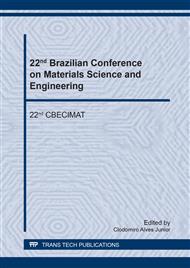p.276
p.283
p.293
p.299
p.305
p.311
p.317
p.322
p.327
Evolution of Individual Grains in 3d Microstructure Generated by Computational Simulation of Transformations Involving Two Phases
Abstract:
In the phase transformations of the solid state, situations can occur in which the initial phase transform forming two or more distinct phases. The exact mathematical model for situations where more than one transformation occurs simultaneously or sequentially was proposed by Rios and Villa. The computational simulation was used to study the evolution and visualization of the possible microstructures that these transformations may present. The causal cone methodology was adopted. The simulations were compared with the analytical model to ensure that they occur as expected. The growth of individual grains of each phase was monitored in 3D microstructure evolution. With this monitoring, was possible to extract useful data able to quantify the simulated 3D microstructure. Quantifying the simulated microstructures increase the possibility of the simulations give to the experimentalist insights about the transformations. In this paper, it is verified that each grain evolves in an individual way, as expected, however their growth is similar.
Info:
Periodical:
Pages:
305-310
Citation:
Online since:
September 2018
Price:
Сopyright:
© 2018 Trans Tech Publications Ltd. All Rights Reserved
Share:
Citation:


